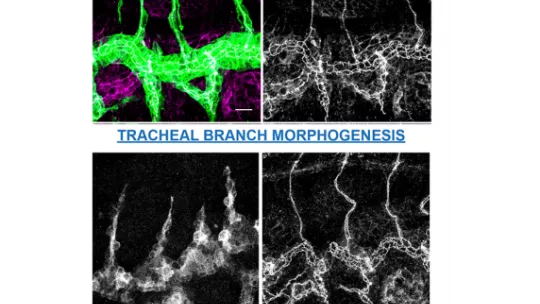Images
A collaboration between the Development and Morphogenesis in Drosophila lab, led by Jordi Casanova at IRB Barcelona, and Marta Llimargas (IBMB-CSIC) has studied cell intercalation in the Drosophila trachea.
The work has been published in Open Biology.
How does cell behaviour contribute to the development of the tubes transporting gases and liquids in living beings? Researchers led by Jordi Casanova (IRB Barcelona, IBMB-CSIC) and Marta Llimargas (IBMB-CSIC) have addressed this question in the development of particular branches of the Drosophila respiratory (tracheal) system and have found that these branches or tubes lengthen mainly through changes in the shape of cells rather than alterations in their relative position.
Intercalation allows cells to exchange positions in a spatially oriented manner in an array of processes, spanning convergent extension in embryonic gastrulation to the formation of tubular organs. However, given the co-occurrence of cell intercalation and changes in cell shape, it is sometimes difficult to ascertain their respective contribution to morphogenesis.
Drosophila trachea as a model organism
A well-established model to analyse intercalation, particularly in tubular organs, is the Drosophila tracheal system. There, the FGF signalling pathway, which plays a key role in the response to injury and tissue repair, generates a ‘pulling’ force at the tip of the dorsal branches that is believed to promote cell elongation and intercalation, which account for the final branch extension.
Intercalation and elongation underpinning the morphogenetic process
“In this study, we used a variety of experimental conditions to examine the contribution of cell elongation and intercalation to morphogenesis and we analysed their mutual requirements. We provide evidence that cell intercalation does not require cell elongation and vice versa,” says Jordi Casanova, co-corresponding author of the article. Also, the article concludes that the two cell behaviours are regulated by independent but simultaneous mechanisms and that cell elongation is sufficient to account for full extension of the dorsal branch, while cell intercalation has a specific role in determining the diameter of this structure.
“Thus, rather than viewing changes in cell shape and intercalation as merely redundant events that add robustness to a given morphogenetic process, we have found that they can also act by contributing to different features of tissue architecture,” says Marta Llimargas, also co-corresponding author of the article.”
Reference article:
Casani S, Casanova J, Llimargas M.
Unravelling the distinct contribution of cell shape changes and cell intercalation to tissue morphogenesis: the case of the Drosophila trachea
Open Biol (2020) DOI: 10:200329
About IRB Barcelona
The Institute for Research in Biomedicine (IRB Barcelona) pursues a society free of disease. To this end, it conducts multidisciplinary research of excellence to cure cancer and other diseases linked to ageing. It establishes technology transfer agreements with the pharmaceutical industry and major hospitals to bring research results closer to society, and organises a range of science outreach activities to engage the public in an open dialogue. IRB Barcelona is an international centre that hosts 400 researchers and more than 30 nationalities. Recognised as a Severo Ochoa Centre of Excellence since 2011, IRB Barcelona is a CERCA centre and member of the Barcelona Institute of Science and Technology (BIST).







